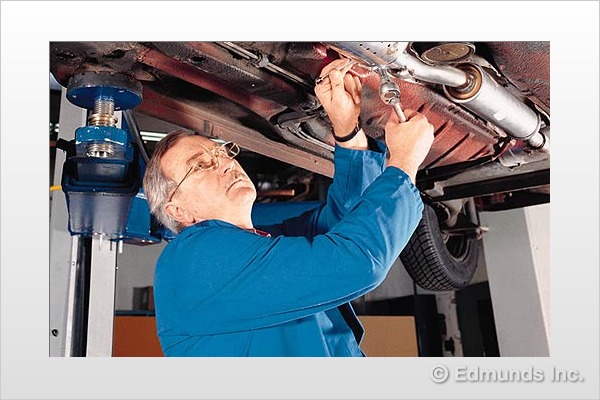
You're buying a car that has a great reputation for reliability — and it even comes with a strong warranty to offset the cost of unexpected repairs. But just before you sign the contract, the dealer offers you a "prepaid maintenance plan." The way it's pitched, it sounds tempting. But is it a smart use of your money? Or is it another profit center for the dealer?
First of all, it's important to understand that a prepaid maintenance plan is not an extended warranty. Typically, prepaid maintenance plans cover only the regularly scheduled maintenance listed in the owner's manual. If the prepaid maintenance plan you purchase is for 36,000 miles and 3 years, then you have prepaid for just what is listed in the plan's contract — usually comparable to the maintenance listed in the owner's manual.
Think of it this way: If you're prepaying, what exactly are you prepaying for? To answer that question, let's look at an average car's maintenance schedule. Or, more specifically, what is the maintenance that is called for in the first 36,000 miles of a new car's life?
The answer is, not much. Basically, most cars require only oil changes and tire rotations in the first 36,000 miles.
Some eagle-eyed readers might now be saying: but what about brake jobs? Brake jobs will usually be required during the first 36,000 miles of a car's use, but since brakes are considered a wear item, they are not covered under most prepaid maintenance plans.
Let's take a brief digression. If you are reading this article, and wondering what maintenance your car requires, there is a very easy way to find out. Check Edmunds.com's manufacturer's recommended maintenance schedule for your car. Edmunds has compiled this information in an easy-to-read format and also included estimated costs for various services. (When reviewing the information, keep in mind that you will be shown the "severe" maintenance schedule which calls for more frequent oil changes than is stipulated under the "normal" schedule.)
Now, back to the question of prepaid maintenance plans. Let's see what the service on a typical car costs during the first 36,000 miles of ownership. Say the normal maintenance schedule on your brand-new car requires an oil change every 7,500 miles and that each oil change costs $25. Throw in a tire rotation at 15,000 miles for about $50. And don't forget the more extensive 30,000-mile check-up, oil change and tire rotation (usually running about $250). Here's a breakdown of the service required and the related costs:
Mileage Estimated Cost Service 7,500 $25.00 Oil & filter change 15,000 $75.00 Oil & filter change, tire rotation 22,500 $25.00 Oil & filter change 30,000 $250.00 Oil & filter change, tire rotation, Mechanical Checks Total $375.00The grand total is $375 for scheduled maintenance for the first 30,000 miles of your car's life. If you paid $900 for a prepaid maintenance plan that covers this work, you're probably not feeling very happy right now. If you paid $400, you're probably feeling OK.
Based on these examples, it's safe to say that, on strictly a dollars and cents basis, the prepaid maintenance plan is not worth it. But let's look at two related factors that might make the prepaid maintenance plan more attractive:
What's convenient about prepaid maintenance plans? A woman we spoke to, who worked in the automotive business, bought GM's two-year prepaid maintenance plan for $375 that covered her vehicle for 30,000 miles.
"I enjoyed the convenience of the plan," she said. "Especially at the end of the day, with eight people waiting to pay at the cashier's window. With the prepaid maintenance plan, it was all taken care of. I was in and out of the dealership while other people were still waiting in line."
Additionally, she knew many other people who bought GM's prepaid maintenance plan and liked them. "People would spend $400 all day (for the prepaid maintenance plan) and they just loved them."
One source we contacted, who used to sell the prepaid maintenance plan in the finance and insurance office of a dealership, said there is also a psychological advantage to buying such plans.
"By pre-paying for all the required maintenance you never have to worry about paying for an oil change or budgeting for any other maintenance item for the duration of the maintenance plan. I believe that the convenience factor is the main reason why people buy the maintenance plans."
However, this expert also said there was substantial profit for dealerships in these prepaid maintenance plans and advised buyers to try to purchase them at a lower negotiated price. Here is his advice on that subject:
"I would suggest asking the service manager of the dealership to give you a list of all the required maintenance with their prices (they have this list readily available at most dealerships). Add them all up (the scheduled maintenance), and this will give you a very good idea about the total cost of maintenance for the car if you paid for it on your own. Dealer's cost for the maintenance plan usually runs around 50 percent of this total. So, offer them about half of this total to begin with." While the dealership will probably make a counter offer, you are still likely to save anywhere from $50 to $300, he said.
In the final analysis, whether or not to buy a prepaid maintenance plan isn't strictly a dollars and cents decision. It has to do with your negotiating skill and your need for financial security and personal convenience. After you weigh these three factors together, the right answer — for you and your lifestyle — should be revealed.